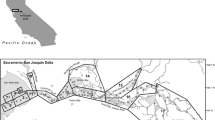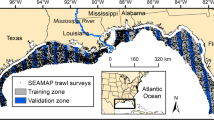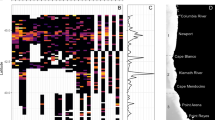Abstract
In the Cook Inlet, a subarctic estuary in Alaska, the endangered population of beluga whales (Delphinapterus leucas) has not recovered despite regulation of hunting and the reason is not well understood. To examine the potential roles of habitat and food availability, we compared spatial data on distribution and abundance from aerial surveys undertaken during the seasonal transition into early summer, with corresponding data for river discharge and salmon abundance. Principal component regression indicated strong relationships with rates of river discharge that explained over 90 % of the inter-annual variability of beluga abundances recorded in the Susitna Delta. Belugas moved away from the Susitna Delta when flow rate from the Susitna River was low relative to rivers draining into the Knik Arm and Turnagain Arm. Using only three principal components describing shape, river discharge during May explained 86 % of the inter-annual variability in abundances recorded in the Susitna Delta. In years of reduced abundance in the Susitna Delta, movement was toward the Knik Arm until 2003, transitioning thereafter to the Turnagain Arm including Chickaloon Bay. In contrast, escapements of Chinook salmon in the Deshka River (a tributary of the Susitna River) showed an inverse relationship with beluga abundance in the Susitna Delta, suggesting that escapements were dependent on beluga abundance. These results demonstrated the influence of highly dynamic habitat availability on the distribution of belugas and the importance of the physical environment in structuring the activity of higher predators on prey species.








Similar content being viewed by others
References
Anonymous (2006) Review of literature on fish species and beluga whales in Cook Inlet, Alaska. LGL Alaska Research Associates Inc., Alaska
Ezer T, Liu H (2009) Combining remote sensing data and inundation modeling to map tidal mudflat regions and improve flood predictions: a proof of concept demonstration in Cook Inlet. Alaska. Geophys Res Let 36:L04605. doi:10.29/2008GL036873
Ezer T, Hobbs R, Oey LY (2008) On the movement of beluga whales in Cook Inlet, Alaska: simulations of tidal and environmental impacts using a hydrodynamic inundation model. Oceanogr 21:186–195
Ezer T, Ashford JR, Jones CM, Mahoney B, Hobbs RC (2013) Physical-biological interactions in a subarctic estuary: how do environmental and physical factors impact the movement and survival of beluga whales in Cook Inlet, Alaska? J Mar Syst 111–112:120–129. doi:10.1016/j.jmarsys.2012.10.007
Hobbs RC, Rugh DJ, Demaster DP (2000a) Abundance of belugas in Cook Inlet, Alaska, 1994–2000. Mar Fish Rev 62:37–45
Hobbs RC, Waite JM, Rugh DJ (2000b) Beluga, Delphinapterus leucas, group sizes in Cook Inlet, Alaska, based on observer counts and aerial video. Mar Fish Rev 62:46–59
Hobbs RC, Laidre KL, Vos DJ, Mahoney BA, Eagleton M (2005) Movements and area of use of belugas, Delphinapterus leucas, in a subarctic Alaskan estuary. Arct 58:331–340
Hobbs RC, Shelden KEW, Rugh DJ, Norman SA (2008) Status review and extinction risk assessment of Cook Inlet belugas (Delphinapterus leucas), AFSC Rep. 2008-02. National Marine Fisheries Service
Hofmann EE, Wiebe PH, Costa DP, Torres JJ (2008) Introduction to dynamics of plankton, krill, and predators in relation to environmental features of the western Antarctic Peninsula and related areas: SO GLOBEC Part II. Deep-Sea Res II
Khattree R, Naik DN (2000) Multivariate data reduction and discrimination with SAS® software. SAS Institute Inc.\Wiley, North Carolina\New York
Malone TC, Conley DJ, Fisher TR, Glibert PM, Harding LW, Sellner KG (1996) Scales of nutrient-limited phytoplankton productivity in Chesapeake Bay. Estuaries 19:371–385
O’Corry-Crowe GM, Suydam RS, Rosenberg A, Frost KJ, Dizon AE (1997) Phylogeography, population structure and dispersal patterns of the beluga whale Delphinapterus leucas in the western near arctic revealed by mitochondrial DNA. Mol Ecol 6:955–970
Oey L-Y, Ezer T, Hu C, Muller-Karger F (2007) Baroclinic tidal flows and inundation processes in Cook Inlet, Alaska: numerical modeling and satellite observations. Ocean Dyn 57:205–221. doi:10.1007/s10236-007-0103-8
Quinn GP, Keough MJ (2002) Experimental design and data analysis for biologists. Cambridge University Press, Cambridge
Ribic CA, Chapman E, Fraser WR, Lawson GL, Wiebe PH (2008) Top predators in relation to bathymetry, ice, and krill during austral winter in Marguerite Bay, Antarctica. Deep Sea Res II 55:485–499
Rugh DJ, Shelden KEW, Mahoney BA (2000) Distribution of belugas, Delphinapterus leucas, in Cook Inlet, Alaska, during June/July 1993–2000. Mar Fish Rev 62:6–21
Rugh DJ, Shelden KEW, Sims CL, Mahoney BA, Smith BK, Litzky LK, Hobbs RC (2005) Aerial surveys of belugas in Cook Inlet, Alaska, June 2001, 2002, 2003, and 2004, NMFS-AFSC-149. National Marine Fisheries Service
Thiele D, Chester ET, Moore SE, Sirovic A, Hildebrand JA, Friedlaender AS (2004) Seasonal variability in whale encounters in the Western Antarctic Peninsula. Deep Sea Res II 51:2311–2315
Acknowledgments
The study was supported by the Kenai Peninsula Borough, award No. KPB 271.21135.90216.43011, NOAA Fisheries Alaska Region, contract No. HA133F10SE3655 and NOAA Climate Programs, Award No. NA08OAR4310613. We thank Roderick Hobbs and Barbara Mahoney of NOAA/National Marine Fisheries Service for providing data and advice.
Author information
Authors and Affiliations
Corresponding author
Rights and permissions
About this article
Cite this article
Ashford, J.R., Ezer, T. & Jones, C.M. River discharge predicts spatial distributions of beluga whales in the Upper Cook Inlet, Alaska, during early summer. Polar Biol 36, 1077–1087 (2013). https://doi.org/10.1007/s00300-013-1330-8
Received:
Revised:
Accepted:
Published:
Issue Date:
DOI: https://doi.org/10.1007/s00300-013-1330-8




